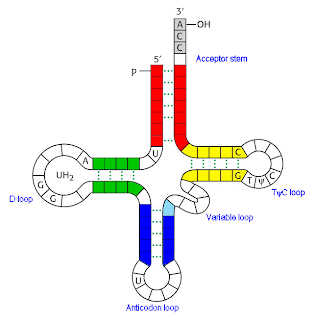-contain C, H, O, N and P, sometimes S
Function:
-energy storage and transport (ATP)
-transport of molecular groups (coenyzme A, NADH, NADPH)
-genetic material, aka nucleic acids (DNA, RNA)
Nucleotides - these are the monomers of all nucleic compounds
-3 parts: 1 pentose sugar, 1 nitrogenous organic base, 1 phosphoric acid
pentose sugar: ribose forms RNA (ribonucleic acid), deoxyribose forms DNA (deoxyribonucleic acid)
nitrogen base: 2 types of bases exist - purines (double ring, a 6-sided ring and a 5-sided ring) and pyrimidines (6-sided ring). There are 2 kinds of purines and 3 kinds of pyrimidines.
Image from http://www.microbelibrary.org/microbelibrary/files/ccImages/Articleimages/Hadfield/Images/Purines%20Pyrimidines%20fig2.jpg
phosphoric acid (H3PO4): gives the nucleotides their acidic character
Nucleotides are formed by condensation reactions binding the pentose sugar, the phosphoric acid and the nitrogenous base.
Image from: www.msu.edu/course/isb/202/ebertmay/2006/drivers/nucleotide.jpg
1. Energy storing and transporting nucleotides
-energy is gained from food (eg. ice cream). Through digestion it is broken down into its various parts, many of which are sugars, which can be broken down by hydrolysis to the simplest sugar - glucose.
Glucose is used in cellular respiration (info on that to come) and energy is released from glucose and used to make new molecules for temporary storage - ATP
ATP (adenosine triphosphate) is the most important molecule in biology (no, I am not exaggerating!). It is the general, universal energy source (which means that all living organisms can use it!)
Image from: http://student.ccbcmd.edu/biotutorials/energy/images/atp.gif
-to release energy, a phosphate breaks off to produce ADP (adenosine diphosphate)
-if another one breaks off, we get AMP (much rarer)
-ATP can be transported to any part of the cell and used for energy-demanding reactions
ADP + P + energy = ATP (to form ATP a condensation reaction occurs, to break down ATP a hydrolysis reaction occurs)
2. Transporting nucleotide-like molecules
-often coenzymes (molecules that help enzymes to complete reactions)
Examples:
Coenzyme A (CoA)
-it is a nucleotide derivative (try to see the similarities with the nucleotide above!)
Image from: http://themedicalbiochemistrypage.org/images/coenzyme_a.jpg
-it takes part in cellular respiration
-its job is to carry acetyl groups that are created during the breakdown of glucose
Image from: http://science.jrank.org/article_images/science.jrank.org/acetyl-coenzyme-a.1.jpg
Nicotinamide adenine dinucleotide (NAD+)
-it takes part in cellular respiration (break-down reaction)
-it carries 2 hydrogens that are dissociated into protons and electrons
Image from: http://www.uic.edu/classes/bios/bios100/lectures/NADH01.jpg
Nicotinamide adenine dinucleotide phosphate (NADP+)
-it takes part in photosynthesis and other "building up" reactions.
-it also carries 2 dissociated hydrogens
3. Nucleic acids (genetic material)
- polymers of thousands of nucleotide monomers form polynucleotide chains by condensation
-the structure consists of a constant pentose-phosphate backbone to which variable nitrogenous bases are attached.
Image from: http://faculty.cbu.ca/eglogowski/BIOL%20101%20IMAGES/NucleicAcidComponent_L.jpg
DNA (deoxyribonucleic acid)
-its unique double helix structure was suggested in 1953 by Watson and Crick
-only 4 bases are used: G (guanine),C (cytosine), A (adenine) and T (thymine), but not U (uracil)!
-the two chains are linked together by H-bonds that form between the nitrogenous bases
-the chains run in opposite directions (this is called anti-parallel) and they are complementary (kiegészitő) to each other. This means that G always pairs with C, and A always pairs with T.
-DNA is found in the cell's nucleus and it defines cell activity by controlling protein synthesis and defining genetic information
Image from: http://www.coe.drexel.edu/ret/personalsites/2005/dayal/curriculum1_files/image001.jpg
RNA (ribonucleic acid)
-usually a single-stranded polynucleotide
-its bases are G, C, A and U (not T!)
-it can fold in on itself (to form short double stranded sections)
3 types:
a. ribosomal RNA (rRNA)/riboszomális RNS
-produced by information in DNA, it is large and complex
-it forms part of the ribosome (this is the organelle that synthesizes/makes proteins, it is formed of proteins and rRNA), so it has a structural role
-all organisms have very similar rRNA (this indicates that it appeared in the living world a very, very, very long time ago)
Computerized image of rRNA, without the surrounding protein
Image from: http://www.biochem.umd.edu/biochem/kahn/bchm465-01/ribosome/16SrRNA.html
b. transfer RNA (tRNA)/szallító RNS
-it is a small molecule
-it is found in the cell's cytoplasm
-it carries amion acids to the site of protein synthesis (to the ribosome)
-there are at least 20 types of tRNA - 1 for each amino acid
-each one binds to a specific amino acid at the acceptor stem
Image from: http://library.thinkquest.org/04apr/00217/images/content/tRNA.gif
c. messenger RNA (mRNA)/hírvivő RNS
-it is a long single-stranded molecule (often 1000's of nucleotides long)
-it is produced in the nucleus and is a mirror copy of 1 strand of the DNA helix
-it enters the cytoplasm, associates with ribosomes, and acts as the template (minta) for protein synthesis
-it is easily and quickly broken down, once it has brought the information about which protein to synthesize to the ribosome
Image from: http://biology.unm.edu/ccouncil/Biology_124/Images/transcription/gif











No comments:
Post a Comment